by Juliann Tallino
We weren’t looking to buy a boat, we definitely weren’t looking to buy a tugboat, we were just looking. We have a home in Port Townsend, Washington but the commute into the city for work was too much to do everyday, so at the time we were renting a house in Ballard (a neighborhood of Seattle). It was a nice house in a great neighborhood, but we really weren’t keen on being renters. When we saw the tug on craigslist we were just curious, but once we looked at the boat we realized we could stop being renters and have a place of our own in Seattle. A place on the water with a million dollar view.

The tug needed a lot of work, the decks needed to be replaced, the interior needed to be completely renovated, and the whole boat was in dire need of a coat of paint. But both my husband and I are comfortable with working in wood, so we decided it was a project we could handle. At first, my husband was worried the space would be too small for the two of us. I work at home and he thought I’d go stir crazy in such tight quarters. But when I thought about how much space I actually used in our rental house, I knew we could make it work. I think most people live in just a small part of their house, the rest of the space is taken up with storing stuff. Luckily we didn’t have a great deal of stuff. So two weeks after seeing the ad on craigslist, we bought a vintage wood tugboat, the Iver.
It took about two months of just looking at the boat to figure out where to start. It was a bit overwhelming, we are not experienced boat owners, we bought our first boat a little over year before, a 28 ft. fiberglass sailboat. We named that boat Troublemaker because we were so clueless about boating.
The first thing we tackled was making the boat water tight, it leaked through the decks. We covered the sides and back deck in cheap plywood and then coated that in a rubberized decking material called Gaco. Then we set about converting the interior into a liveable space. We tore out everything the previous owner had built, which wasn’t really much. A poorly designed galley area, a platform bed in the f’o’clse (the area under the bow deck) and a too large vanity in the head.
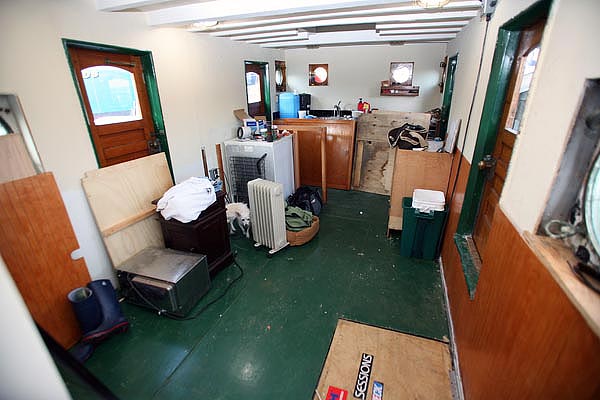
The galley cabinets were built in place, nothing on a boat is straight, especially an 85 yr old boat. We replaced a small electric marine stove with a household gas stove converted to propane. The shelves in the cabinets all slide out and the space between the stove and small fridge is a can pantry drawer. We later added a dish storage rack between the portholes on the back wall.
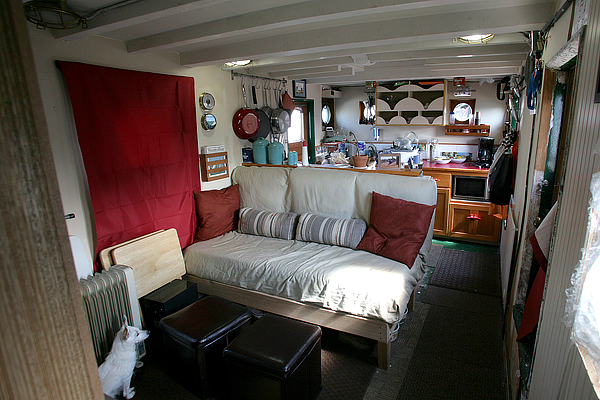
The rest of the cabin is our sitting, computer, TV area, guest bunk and dining area. We built a settee from wood we salvaged from my old work desk that my husband had made for me from a nice oak pallet he found on a construction site. The cushion is cut from a thick full sized foam mattress we had in the attic in Port Townsend. The settee is about the size of a twin bed and we made it high enough off the floor so we could put the dogs food and water dishes underneath and out of the way.
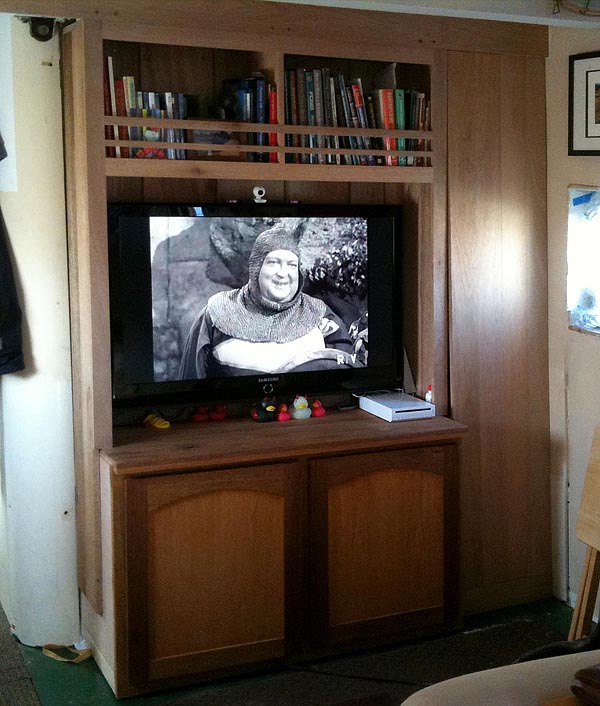
On the opposite wall we built an entertainment unit to house our flat screen TV with storage for laptops and other stuff, as well as a small bookcase. This wall hides the exhaust stacks that come up from the engine room, to the right was a bit of dead space that we turned into a wet/dry locker by adding a door from the built-in to the wall. The wood we used is mahogany tongue and groove that was salvaged from a house on Lake Washington.
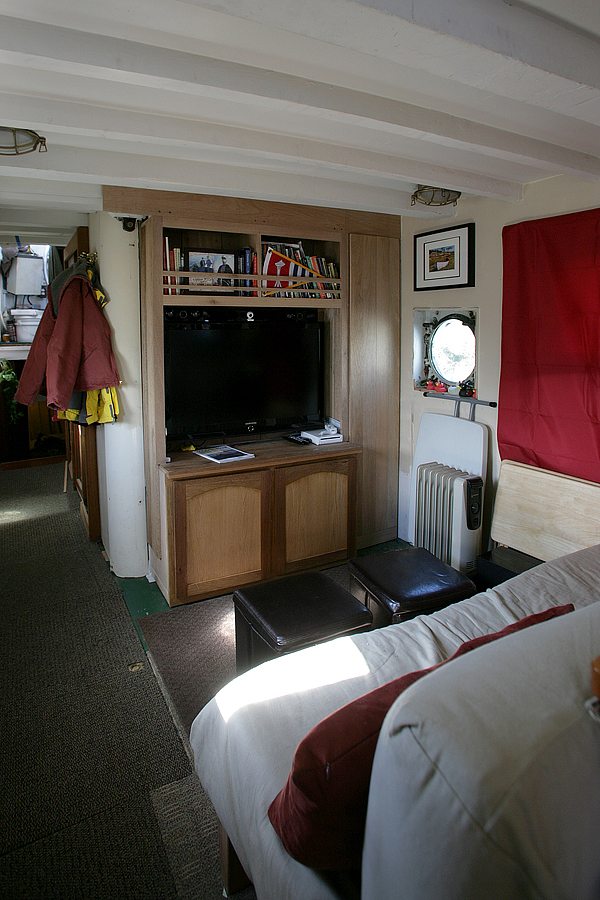
Our stateroom is in the f’o’scle (boat lingo for the area below the bow deck) we built a queen size bed frame with storage underneath. We had a hard time figuring out how to get a regular mattress down into the space, but found a sleep number bed was the perfect fit. It came apart and we could put it back together in place. Getting big things in and out of the tug is always a challenge, the doors are not normal house door size, they’re a bit on the small size. When we brought in the gas range, it had to come in through a hole in the cabin ceiling that will someday be a nice skylight hatch.

We then built in a hanging locker (boat for closet), a six drawer dresser (using that old desktop that was leftover when we built the settee) and shelves with doors. Plenty of storage for clothes and linens.
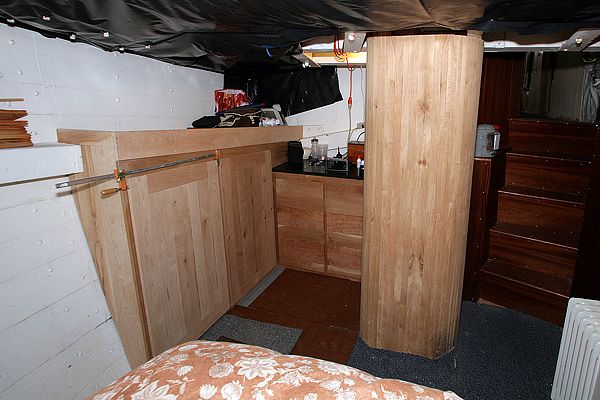
One of the most challenging aspects of renovating the tug as a live aboard was what to do about the toilet in the head. The toilet that was in the boat when we bought it was plumbed to flush directly out of the boat. Not only was that really gross, but it was also very illegal. To install a marine black water system would have been difficult, there was no way to get a decent sized black water tank down into the engine room (remember those small doors, the hatch down into the engine room is even smaller) and paying someone to come pump us out every week just didn’t sit well with me. We could have installed a waste water treatment system, but that was really expensive and possibly not totally legal in our no discharge area of the ship canal. After much research I came up with the idea of installing a dry composting toilet. My husband was not thrilled with the idea, but he couldn’t come up with a better plan, so……..
The commercial units available at that time were a bit expensive, but I found a DIY option that turned out to be inexpensive, easy to build and works very well. My husband is now a complete convert and we plan on replacing the marine head on our sailboat with a dry composting toilet.

We also replaced the large vanity with a smaller unit and did some upgrades on the plumbing fixtures.

We bought the boat in September of 2009 and moved on board July 1st, 2010. While renovating our new home we try to be green, using salvaged materials as much as possible. I joke that we should have named the tug “Craigslist” since that’s where we find most of our materials, especially old growth lumber for replacing the decks. We also shop all the re-use and salvage yards in the area. Our carpet tiles in the salon and subway tiles in the kitchen came from the local Habitat for Humanity Re-Store. I made lights in the galley from old coffee cans and just finished painting a floor cloth for the galley from a scrap of vinyl flooring.
During the time we were building in the living spaces, we were also working on the plumbing, replacing old PVC pipe with pex pipe and putting in new freshwater filtration system. Our water comes from a heavy duty garden hose that runs down the dock, the electrical is all household 110v that also comes from the dock. My husband and I work well together, we design everything as a team, he does most of the woodworking (he just likes doing it more than I do) and I do the majority of the painting and varnishing (I hate painting a bit less than he does). We love living on our tug, we find we have plenty of space and being able to live on the water is amazing. Life should be an adventure, right? Sometimes it’s work, but it’s almost never boring. 🙂
Juliann Tallino
www.Tallinophotography.com
Love your story..Awesome.
So if you have a composting toilet, where do you do the composting?
We don’t really have use for the compost, what we do is once we remove the solids bin we put it in a plastic storage bin with vent holes and leave it for another 4-6 weeks to break down further. Then we dump the contents into a construction grade (very thick mil) garbage bag, double bag it and put it in the dumpster. We have two solids bins, so we can switch out. I have been thinking of getting a big rotating composter bin so we can truly compost, but most folks with composting boat toilets just bag it up and dump it in the dumpster. Even after it’s in the plastic garbage bag, we tend to leave it sit for several more weeks, just to get it broken down as far as possible before disposal.
Very charming. I often think that living on a boat like this would be an adventure. Do you have any pets? I have a Min Pin and would worry that he would fall overboard.
We have two dogs, a Jack Russell/Chihuahua mix (you see him in the photo of the salon sitting next to the space heater) and a Chihuahua. Wylie the Jackhuahua, did fall in, but from the small beach area of the boatyard not the tug, he thought the floating log was much more stable than it actually was, he has not ventured that close to the water since then. The Hua (pronounced “who ah”)the chihuahua has more sense. 🙂 When we take them out on the sailboat they wear life jackets and I tie them on a jack line so they can walk around but if they did somehow fall overboard, I could reel them in with the line. I think poor Wylie gets seasick so he spends most of his time on the sailboat down below lying on the settee.
We have 4 liveaboards (2 are tugs) in our little boatyard and everyone has a dog, not to mention all the workers that bring their dogs to work. it’s like a dog park around here. 🙂
I am definitely leaning toward the dry compost toilet for our small space. My husband is super worried about smell though, are you having any issues? So glad to hear your husband is a convert! Also was wondering where your “work area” is? Do you sit on your sofa or?
The toilet works better than I had hoped for, in Sweden they use these types of toilets in houses and even apartment buildings. There’s really no smell issues if you do a minimum of maintenance. The only time you get a smell is if the liquid bottle is not rinsed well (I like to soak it a bit with a little bleach water after it’s emptied) or if someone does not cover a deposit in the solids bucket, it just takes a scoop of whatever cover material you are using and a crank of the handle. We can go 4-6 weeks before emptying the solids bin.
We have a workshop in the boatyard (metal shipping container) otherwise I’m on the couch working on my laptop.
love this. i appreciate you sharing.
Keen story, kinda envious! Will look for more posts!
Great story .Good for you.I hope to do the same thing in the near future.Can’t wait to retire.
Looking good..Fantastic..
Wow;great story. I loved reading this. You guys did an amazing job…what an amazing story too!
Wow. Wow wow. I think it would be so cool to live on a restored tug. You have done a great job here- what an adventure!
(Yeah- I read Kon Tiki about 8 times while in middle school. I’m a landlubbing boat geek.)
You have quite an adventure getting your home ready, and now an even bigger one living on it. Good for you! – Margy
I always love the tiny house boat stories and tugs are so great! Funny how life works out; you’ve done a wonderful job and now joined the world of liveaboards, enjoy!
This story is an example of why I sometimes wish I lived in the PNW. Vessels like this just aren’t available on the east coast anymore! Fantastic!!
Love it!!! As a child I always thought it would be fun to live in a houseboat. As an adult, I settled on my caboose. You have come up with some very clever ideas. Don’t you just love unique homes?
My hats off to you. My wife and I looked at an 85′ steel trawler in the early 80’s. like all things nautical, 85′ is a big hole in the water to throw money. A bargain is usually anything but when it comes to water craft. I assume this was purchased without a vessel survey? Lack of a basic plumbing retrofit and a waste holding tank should have been the first consideration. Composting toilet or not, you still have other waste issues including bilge that contains oil and fuel that can not be direct discharged in the sound. another is electrical on those old tugs would have made me consider very carefully what I’m getting into but the real lynch pin was using “cheap” plywood as a deck replacement. If it wasn’t marine grade at a minimum, you just advanced the crafts demise a few decades ahead of schedule. I do admire at least trying this and hopefully you learn a valuable lesson when 6″ of wet snow sets on the deck.
Plywood deck covering (not replacement) is temporary and common for wood boats until you have the chance to replace the decks. We have several hundred board feet of tight grain old growth doug fir that will replace the decking when we get to that point. Plumbing on a boat is minimum at best, we have the skills for both that and the electrical. We may not have been shipwrights before we bought the boat but we have experience in all phases of construction, and since my husband grew up on farms, he’s very familiar with large diesel engines and once held union cards in the carpenters, pipe fitters and welders halls. We’re not stupid.
I wonder if there’s some kind of formed in place tanks you could make? I know there are flexible ones, like a bladder type thing for black water. Some here http://www.pyacht.com/vetus-flexible-waste-tanks.htm
Probably, but carrying around a large tank of raw sewerage just didn’t appeal to me, we could use the space for other less smelly/gross things. 🙂
Any kind of house-on-the-water, whether a houseboat with which Seattle is replete, or a converted tug (used to be a wonderful Bunk n’ Breakfast on Lake Union) requires a pier to tie up to. That’s always the problem. Renting wharf space. Especially when a developer buys up the waterfront for new condos, evicting everybody from their rented berth. I am curious how the wharf rental compares with rent for an apartment?
Yes, it is best to look at the moorage first – otherwise it’s like owning a double-decker bus in NYC.
Unfortunately Seattle has suddenly decided to persecute houseboaters of all kinds, so a self-contained greywater-recycling craft is under suspicion (while landowners dump hazardous materials into the sewers leading to the lake…)
For now liveaboards are off the hook so long as they use the boat “in a manner consistent with its use”. Whether that means tugboat owners should nudge people along, fireboat owners should look for blazes, etc is unknown at this point. (Of course the houseboat communities have been around since the 1800’s, and the first small boat owners lived aboard and cruised the world, but Seattle bureaucrats know nothing of maritime history – just want the pricey waterfront all to themselves!)
It depends on the marina, it’s a bit cheaper on the freshwater side of the locks. There’s actually quite a few of us tugboat liveaboards here in Seattle, most of us are on the lake or in the ship canal. Moorage rates can run from $8-$10.00 a foot to $10-$15.00 a foot in saltwater. The price difference is mostly because of the locks. There are a number of small privately owned marinas and boatyards along the ship canal and lake union. Finding moorage for a larger boat can be a challenge but it’s not impossible.
Would you share the DIY info on your composting toilet? I haven’t seen one like it. There’s a molded component that separates #1 from #2?
Hi Sheri,
We used the seperatt kit from ecovita.net but you can also get a DIY kit from Sandy Graves at C-Head.com.
I was really taken aback when I got to the photo of your living area. It is just wonderful. And I agree with you, “I think most people live in just a small part of their house.” You’ve both done an amazing job!
I was wondering if you have any intentions of sailing the tugboat and is the engine in working order.Here in England we have boats called narrow-boats, which mostly stay on the channels that are extensive and lot’s of people live aboard them And they also use the same toilet system. Not all but allot do. I would love to see a picture of the Bridge if you have one. and good luck with your project.
Regards Peter
The tug runs fine, our long range goal is to take her up to Alaska. Short term is cruising around the sound and the Canadian Gulf Islands. You can see more photos of the boat on my blog http://ourtugboat.blogspot.com/
I would have suggested an Incinolet for the head.
A friend has one of those on his tug, they are very nice and very expensive. 🙂 Somewhere around $2K, a lot of money for a toilet in my opinion.
Nice lil home. Looks peaceful.
What a wonderful home you have made yourselves. We live on a 45′ trawler ourselves up in La Conner, WA. We bought it “as is” as well and have been working on it ever since Oct 2010.
I would not do the compost toilet and was lucky to have room for a 50 gallon tank which is pumped once a month. I have to hire a carpenter unfortunately but I can do all the other tasks luckily.
I am a long time old wooden boat owner. I pass by you tug fairly often and actually had my eye on it for some time. I noticed you bought it from craigslist. It was mentioned that you didn’t get a survey. I have noticed your boat hasn’t moved from that spot for over 8 years. IT hasn’t been out of the water for at least that amount time. Based on the marina and class of boats directly surrounding you I think it is a sure bet there have not been zincs for some time. Leaking decks, rotten deck beams,bullwork covered with plastic and a hefty list to the other side of the boat does not bode well for the boat’s future. You are committing the worst kind of mistakes.Dumping your hard earned money into the house built on sand. Without an out of the water survey by a certified survey professional you can’t get wooden boat insurance. So you are uninsured.
I tell you these things because I hate to see yet another wooden boat lover go belly up after years of hard work. My wife and I had your very same experience,but bailed out before to much finical damage was done. Our friends insisted we quit.
Unless you floating in a sea of money(which I doubt since people with money don’t buy boats like yours)your boat will still be sitting there five to ten years from now if it hasn’t already sunk.
I found a similar sized Tug in LaConner WA. in 1992 and used the 1892 square stern style to build my “Annie” for the Kenai River in Alaska.www.tugboatwilly.com I will be putting pictures up on my 4Fathoms Design face book pages soon.
We love the liveaboard lifestyle. But our plans have changed and we are selling our historic tugboat. Your story was really inspiring and I hope that the next person who finds our home loves it as much as we do!
https://post.craigslist.org/manage/3986635534/zpbku
Looking to purchase a tug myself. Did you get financing for the boat or did you pay cash?
I came here because I’m writing a column about shipwreck salvage and wanted to do research on converted tugboats because that’s the shipwreck I’m writing about.
I live in a remote part of SE Alaska and blog at http://www.alaskaforreal.com (and write a column for the Juneau Empire). The interior of my floathouse has some expensive items in it thanks to a couple who converted a tugboat and then took it on an adventure to Alaska.
Its planks opened up and it started taking on water not too far from where I live. In order to save it they ran it up on the nearest beach, in a semi-protected bay. But when the tide went out the stern was uphill at a severe angle and it broke its back. When the tide came in its bow remained underwater and it was a total loss.
It was declared “open salvage” by the insurers and the locals, including me, wound up with some very expensive items that this poor couple lovingly built into their floating home. The locals noted that the hull was full of rot–it was a miracle that everyone aboard escaped with their lives.
Pleasue have these old boats carefully examined by professionals before you sink your life savings (literally) in one. Especially if you plan on taking it up to Alaska.
Hi,Can you tell me what the name of the tug was when you bought it? Looks like one my grandfather worked on in Alaska.
Thanks Vicki